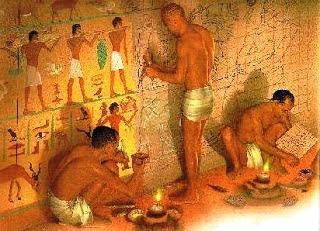The painting of Ancient Egypt, like other forms of art, was constantly dependent on religious requirements, which was expressed in its special development, which had a cult character. Traditionally, it is characterized by strict formalization, following certain canonical patterns or artistic standards that developed back in the era of the Old Kingdom, during the first and second dynasties. So, the figure of a person was depicted in profile (or rather the head and lower body - in profile, and the eyes and shoulders - in the face). On the other hand, it should be said about the high degree of realism that prevails in the pictorial descriptions of objects of nature, agricultural and other practical human activities. The main colors used by ancient Egyptian artists are white, red, blue, black, yellow, silver and green.
At first glance, it may seem that the painting of Ancient Egypt remained unchanged for millennia, but this is not so. It developed and changed depending on how society itself developed and changed. And even in the strict framework of canonical art, some art schools and individual masters showed their creative ideas.

In general, the image of a person in terms of full-face and profile is one of the main features of Egyptian art. The painting of Ancient Egypt is characterized by complex images of most of the identifying signs and parts of man, which were more detailed than the image of any realistic pose, since they helped Ka (or ku), the second shell of man, representing his energy counterpart or double soul and who lived in the tomb, unmistakably to recognize the deceased and inhabit him. Therefore, the portrait similarity of a pictorial or sculptural image was very important. In theory, the mummy was supposed to be a haven for Ka, but if it was damaged, it moved into the image. When portraying people, their social status was taken into account. It was described by such elements as a costume, hats, ceremonial accessories, which were in the hands of the depicted person. In other words, the painting of Ancient Egypt, which is an extremely interesting and vivid example of art, focused solely on the representation of images.

Most of the paintings (in tempera technique) were painted on stone or plaster, consisting of layers of gypsum, straw and clay. As a rule, artists worked in groups under the guidance of masters. Masters applied the contours and details of future images, and artists painted them. They were painted with pigments, which were obtained as a result of various chemical processes, all of them were very symbolic. As in medieval Europe, Egyptian painting did not belong to a specific type of human activity — craft or art. In other words, if we take the Egyptian artist in the modern concept, he did not represent a creative person. Therefore, it is impossible to name the names of any specific artists, famous for their outstanding achievements.
Given the extreme religiosity of Egyptian civilization, most of the themes in the painting are associated with images of gods and goddesses, the pharaohs were one of them. An artistic rule such as a linear perspective did not exist in the minds of Egyptian artists. The main emphasis was placed on the size of the figure, the larger it is, the higher was the social status of the depicted person.

A kind of cultural revolution took place in the country during the reign of Pharaoh Amenhotep IV (Akhenaten). The incredible religious reform, which consisted of a commitment to monotheism (monotheism), carried out by Akhenaten, introduced radical changes to art. It has become naturalistic, dynamic. Portraits of the Egyptian nobility were no longer idealized, and some of them were even caricatured. But after Akhenaten’s death, everything returned to the old traditions characterizing ancient Egypt as a whole. Art was still determined by conservative values and strict order until the Hellenistic era.